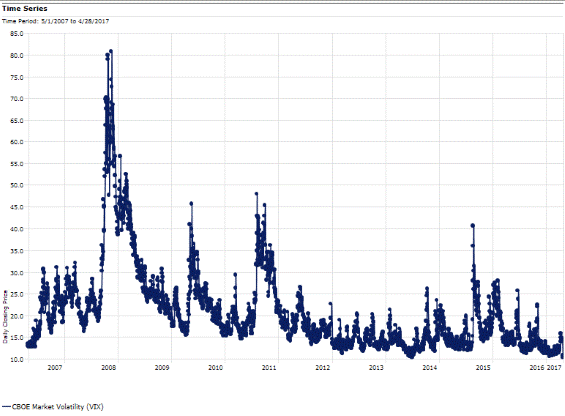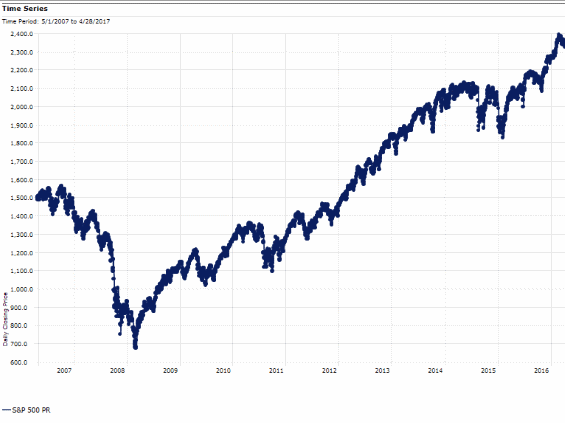What the Heck Is the 'Fear Gauge,' Anyway?
The VIX can tell you how uncertain financial markets are about the near future, but little more.
Long followed closely by professional traders and risk managers, the CBOE Market Volatility Index--better known as the VIX--became a colloquialism around the time of the global financial crisis. We haven't heard as much about it in recent years, as markets have been eerily calm and on an upward trajectory. But when the market plunged 2% on May 17 after reaching all-time highs, the financial media and investors alike contemplated the VIX with renewed interest.
"Technically, the VIX is the 30-day implied volatility of options on the S&P 500. Translating that to English, the VIX is an estimate of how much big stocks are expected to move around over the next month," said Phil Guziec, Morningstar's senior product manager for buy side software.
The VIX is a forward-looking indicator, and because its value is derived from both puts (options to sell a stock) and calls (options to buy), it does not attempt to predict what direction markets are expected to head, just at how bouncy the path will be over the next month.
Stocks move in response to expected future earnings, so the VIX is also an estimate of how much market-moving information is expected over the next month, Guziec said. Another concise way to look at the VIX is as a measure of uncertainty. The more uncertain the future, the higher the VIX.
Because it typically slowly creeps down in response to market stability, but spikes suddenly when markets move, it is commonly called the "fear gauge." It is better to think of the VIX as an "uncertainty gauge" but, in financial markets, uncertainty typically has more of an impact to the downside than the upside.
Bull markets are often characterized by steady advances with low standard deviation of returns, while the occasional correction, crash, or credit crisis is generally accompanied by a sharp increase in volatility. Hence, the VIX index has a negative historical correlation to equities: It's negative 0.68 over the 10-year period, and negative 0.78 over the five-year period.
Take a look at the figure below, which shows the daily closing prices of the VIX over a 10-year period ended April 28, 2017. The VIX's long-term average value hovers around 20%, which is also the long-term average annual volatility of the S&P 500--or how much the S&P 500 moves around in a typical year.
"When the economy is humming along, companies are making money, and there are no pending events that are likely to mess with that happily ringing cash register, the VIX tends to fall below that 20% average, down as low as the 10% range," Guziec said. "Conversely, when nobody knows if the world will end (meaning, to markets, that companies will never make money again), it gets near 100%, like it did during the 2008 financial crisis."

Source: Morningstar Direct
By contrast, the figure below shows the S&P 500 PR's 10-year daily closing price chart. You can compare the peaks in the VIX's price to the some of the notable valleys in the S&P 500's.

Source: Morningstar Direct
Does Volatility as an Asset Class Work? In addition to an index of uncertainty, the VIX has become a financial product unto itself, and one can trade futures on the VIX to "invest" in moves in volatility. The CBOE has also expanded the "VIX" brand by creating products with longer tenors, or different "VIX" products focused on options on different industries.
Among other investable products, Barclays launched a couple of exchange-traded notes, iPath S&P 500 VIX Short-Term Futures ETN VXX and the iPath S&P 500 VIX Mid-Term Futures ETN VXZ in January 2009. (It was not the most auspicious timing, to put it mildly, as shown by the growth of 10,000 graph for the short-term futures ETN.)

Source: Morningstar.com
There are also some VelocityShares Daily Inverse exchange-traded note products that allow investors to bet against the VIX: VelocityShares Daily Inverse VIX Short-Term ETN XIV, and VelocityShares Daily Inverse VIX Medium-Term ETN ZIV. (Prospective investors should note that with an ETN they are taking on credit risk in addition to the risk of the investment itself, and leveraged funds are only designed to offer the inverse of the daily return of the index.)
In addition, ProShares launched two exchange-traded funds in 2011: VIX Short-Term Futures VIXY and VIX Mid-Term Futures VIXM.
The appeal of such products is somewhat understandable. The VIX's low correlations to stocks are intriguing to some people looking for a way to hedge against stock market declines. And in theory, it should work, as the VIX tends to spike when a portfolio crashes, Guziec said. But in practice, there are significant costs associated with investing in VIX futures (they are subject to the vagaries of backwardation and contango, and positive and negative roll yield, respectively). Also, such a strategy would undoubtedly require frequent rebalancing, so in practice it really doesn't make sense for most investors.
In short, investors can use the VIX to understand how uncertain financial markets are about the near future, but little more.

/s3.amazonaws.com/arc-authors/morningstar/3a6abec7-a233-42a7-bcb0-b2efd54d751d.jpg)
/cloudfront-us-east-1.images.arcpublishing.com/morningstar/MFL6LHZXFVFYFOAVQBMECBG6RM.png)
/cloudfront-us-east-1.images.arcpublishing.com/morningstar/HCVXKY35QNVZ4AHAWI2N4JWONA.png)
/cloudfront-us-east-1.images.arcpublishing.com/morningstar/EGA35LGTJFBVTDK3OCMQCHW7XQ.png)
:quality(80)/s3.amazonaws.com/arc-authors/morningstar/3a6abec7-a233-42a7-bcb0-b2efd54d751d.jpg)